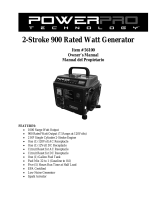
TABLE OF CONTENTS
GENERAL SAFETY PROCEDURES ................................................................................................................................. 1
PACKAGE CONTENTS ....................................................................................................................................................... 5
GENERATOR COMPONENTS .......................................................................................................................................... 6
ASSEMBLY ............................................................................................................................................................................ 7
Attach Handles .............................................................................................................................................................. 7
Attach Wheels ............................................................................................................................................................... 8
Attach Foot .................................................................................................................................................................... 8
PREPARING THE GENERATOR FOR USE .................................................................................................................... 9
Using the Generator t\_rthe First Time ......................................................................................................................... 9
Step 1- Connect the Battery ................................................................................................................................ 9
Step 2- Add oil .................................................................................................................................................. 10
Step 4- (hound the Generator ........................................................................................................................... 11
Subsequent Use of the Generator ................................................................................................................................ 12
Step 1- Check the Oil........................................................................................................................................ 12
Step 2 Check the Gas Level ........................................................................................................................... 12
Step 3- Ground the Generator ........................................................................................................................... 13
STARTING THE GENERATOR ....................................................................................................................................... 14
Electric Start ................................................................................................................................................................ 14
Manual Start ................................................................................................................................................................ 15
USING THE GENERATOR ............................................................................................................................................... 17
AC Usage .................................................................................................................................................................... 17
DC USAGE ................................................................................................................................................................. 19
STOPPING THE GENERATOR ....................................................................................................................................... 20
MAINTENANCE / (;ARE ................................................................................................................................................... 20
Cleaning the Generator ................................................................................................................................................ 21
Checking the Oil .......................................................................................................................................................... 21
Changing/Adding Oil ................................................................................................................................................. 21
Air Cleaner Maintenance ............................................................................................................................................. 22
Fuel Filter Cup Cleaning ............................................................................................................................................. 23
Spark Plug Maintenance .............................................................................................................................................. 24
Emptying the Gas Tank ............................................................................................................................................... 24
Changing the Battery ................................................................................................................................................... 25
STORAGE / TRANSPORT PROCEDURES .................................................................................................................... 25
SPECIFICATIONS .............................................................................................................................................................. 26
TROUBLESHOOTING ...................................................................................................................................................... 27
EXPLODED VIEW AND PARTS LIST ............................................................................................................................ 28
WIRING DIAGRAM ................................................................................................................ Error! Bookmark not defined.
LIMITED WARRANTY FOR POWER PRO TM GENERATORS FROM WEN POWER TM ...................................... 32
NOTICE REGARDING EMISSIONS
Engines that are certified to comply with U.S. EPA emission regulations for SORE (Small Off Road
Equipment), are certified to operate on regular unleaded gasoline, and may include the following
emission control systems: (EM) Engine Modifications and (TWC) Three-Way Catalyst (if so
equipped).
























